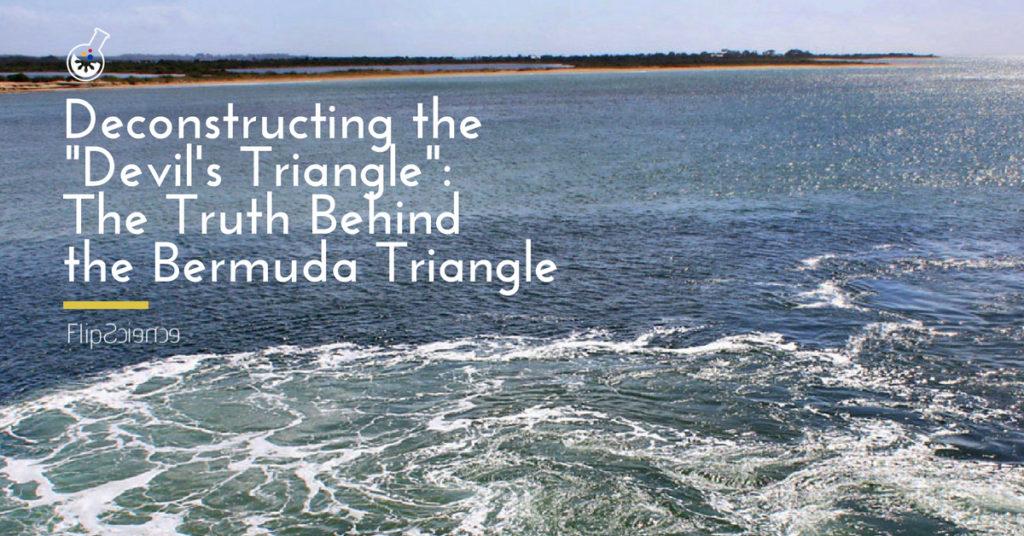For over half a century, we’ve been hearing all sorts of stories about the Bermuda Triangle, ranging from terrifying to downright crazy.
Since the 1950s, various aircraft and ships have disappeared within the supposed boundaries of the Bermuda Triangle, typically under “mysterious circumstances.” Some folks say that the disappearances have something to do with paranormal and supernatural activities. Others suggest that the planes and ships were taken by extraterrestrial beings. Some even claim that the Bermuda Triangle has a spiral vortex that takes the vehicles passing through it to another mythical location: the fabled city of Atlantis. So well-known and well-feared is the Bermuda Triangle’s reputation that it even earned itself an ominous and sinister nickname: The Devil’s Triangle.
This hasn’t really deterred anyone — from newscasters to online conspiracy theorists — to refer to it by its colloquially known nomenclature, though.
The Bermuda Triangle: Mystical mystery, or manufactured myth?
Many remain unconvinced that the mystery behind the Bermuda Triangle is paranormal in nature. Larry Kusche, an American pilot who wrote the book The Bermuda Triangle — Solved in 1975, argued that the stories behind the Bermuda Triangle disappearances have simply been greatly exaggerated.
Kusche called the myth a “manufactured mystery,” attributing it to “writers who either purposely or unknowingly made use of misconceptions, faulty reasonings and sensationalism.”
Meanwhile, Australian science communicator Dr. Karl Kruszelnicki has gone on record to say that the high number of disappearances in the Bermuda Triangle can be largely attributed to human error, heavy traffic, and bad weather conditions.
It will certainly take more time and research (and courage) to fully understand and explain the Bermuda Triangle. That does not mean, however, that we cannot use science, research, or plain old common sense to debunk some of the most persistent rumors and stories surrounding it.
To err is human, to crash is…?
On December 5, 1945, Flight 19, comprised of a group of of five US Navy Grumman TBM Avenger torpedo bombers on a training mission, somehow managed to get lost in the Atlantic, only to mysteriously lose radio contact and seemingly disappear from the face of the planet. It became one of the first recorded aircraft disappearances to be attributed to the Triangle, and subsequently helped in building up its infamous reputation.
What was initially perceived as proof of the Triangle’s insatiable appetite for ships and planes, however, is now believed to have been the result of a possibly alcohol-influenced miscalculation. In fact, some scientists and historians claim that Flight 19 didn’t vanish without a trace — the planes may have actually blown up.
In an interview with news.com.au, Dr. Kruszelnicki shared his theory: Flight 19’s leader, Lieutenant Charles Taylor, decided to continue flying east instead of going west (as he was instructed to do), leading to their grim fate.
“If you read the radio transcripts some of the junior pilots are saying, ‘Why don’t we fly to the west?’, and the pilot says, ‘Why don’t we fly to the east?’
“(Lt. Taylor) arrived with a hangover, flew off without a watch, and had a history of getting lost and ditching his plane twice before.”
This isn’t exactly a stretch, as it is sadly not unusual for such navigators to be under the influence of alcohol while flying. Combine that with the possible lack of appropriate safety gear on board, and the whole thing begins to look more like a doomed recipe for disaster than actual evidence of supernatural maleficence.
The Triangle, tropical waters, and terrible weather
It also doesn’t help that the Triangle’s 700,000-square-kilometer swath of ocean happens to be a particularly busy patch of water.
The Triangle’s main vertices are Miami (Florida), San Juan (Puerto Rico), and the Bermuda itself. It’s one of the most heavily traveled shipping lanes on the planet. Compare the number of disappearances in the Bermuda Triangle to the sheer number of ships and planes passing through it. It will become clear that there is actually nothing so extraordinary about the statistics at all.
In fact, Dr. Kruszelnicki claimed that in terms of percentage, the number of ships and planes that went missing in the region of the Triangle is roughly the same as anywhere else in the world. (Never let it be said that your statistics lessons from high school have no practical use outside the academe!)
Whenever the Bermuda Triangle gets brought up, among the first images that come to mind is that of a powerful, merciless hurricane, trapping helpless ships and spinning them around and around until they meet their inevitable fate in the dark, murky waters below.
There’s historical basis for this, as hurricanes have been known to literally and figuratively stir up trouble in tropical waters. We’re talking body counts in the thousands and financial damage in the billions. Thus, it is not entirely surprising to think that a good number of these Triangle-related disappearances may have been brought about by less-than-ideal weather.
As National Hurricane Center satellite specialist Jim Lushine explained:
“Many others, whose centers have skirted the area, have also produced high winds and waves in the area. This is likely the reason that so many boats and planes have ‘disappeared’ there [in the Triangle].”
Hate to burst your (methane) bubble, but…
Others suggest that methane bubbles from under the Triangle could be causing the sea to swallow up the ships and planes that pass through it.
At first glance, this isn’t such a farfetched possibility. Largely originating from frozen caches beneath the Atlantic, methane bubbles are powerful enough to agitate the sea and cause numerous boats to capsize. In Australia, researchers conducted experiments using scale models, proving that with the right water density, such bubbles can indeed cause ships to rapidly sink.
This would have been a great theory for explaining the Triangle disappearances… that is, if these incidents had happened near the end of the Ice Age.
You see, the last naturally occurring hydrate gas blowout off the southeastern United States happened near the end of the last glacial period, at least 15,000 years ago. Since then, no methane bubble phenomena of this nature or magnitude have been observed.
A theory with a huge, hexagonal hole
Still, others have pointed out the existence of hexagonal (or “honeycomb“) holes in the clouds above the Triangle. They believe that significant blasts of sinking air caused the mysterious shipwrecks and plane crashes in the area.
A climatologist from Arizona State University, Randall Cerveny, explained that those holes were the results of microbursts, blasts of air that come out from the bottom of a cloud, hit the ocean, and create potentially massive ocean waves (over 40 feet high) and strong winds (up to 100 mph). Identical cloud formations have been spotted over the North Sea near the United Kingdom.
However, according to meteorologist Kevin Corriveau, the honeycomb clouds above the Triangle don’t exhibit the characteristics one would normally expect to see in a microburst.
“You would normally have one large to extremely large thunderstorm that wouldn’t have an opening in the middle.”
Corriveau added that the weather patterns in the area of the Triangle is too different from those in the North Sea, making any comparison between the two rather unsound. Instead, he believes that the Triangle’s erratic weather patterns are the result of a difference in the way small islands heat the air, as opposed to how it happens along the Florida coastline.
Oh, and in case you were wondering why compasses reportedly malfunction within the boundaries of the Triangle, watch this:
The big question
Whether in the news, in popular culture, or even across the internet, we periodically hear or read about the mysteries involving this loosely defined region of the Atlantic Ocean. The operative words here, however, are “loosely defined,” which begs the question: Does the Bermuda Triangle even exist in the first place?
Officially, no.
That’s right: After more than a century of sensationalism and speculation surrounding the Triangle, it still isn’t legally recognized, and with good reason.
According to the National Oceanic and Atmospheric Administration (NOAA), the Triangle doesn’t officially exist. As the NOAA has pointed out, there is “no evidence that mysterious disappearances occur with any greater frequency in the Bermuda Triangle than in any other large, well-travelled area of the ocean.” Indeed, not a single credible science organization in existence recognizes the myth of the Triangle as irrefutable truth.
In fact, the United States Board of Geographic Names neither acknowledges it nor keeps a file on it, since no legitimate maps exist to legally delineate the Triangle’s boundaries.
Admittedly, it’s fun to think of and discuss conspiracy theories, especially when it comes to subjects as popular and controversial as the Bermuda Triangle. However, the Triangle’s infamy should not stand in the way of our capacity to think and assess situations objectively, especially in this age of fake news and unverified claims.
Otherwise, our fear of the Triangle could very well lead to it claiming its most important victim: Our rationality. –MF
Cover photo credit: Andrew (@sneetchbeach) | Flickr
References:
- https://books.google.com.ph/books?id=efQCIrtzN4IC
- http://www.iflscience.com/environment/the-mystery-of-the-bermuda-triangle-has-been-solved/
- https://www.independent.co.uk/news/science/bermuda-triangle-mystery-solved-latest-theories-dr-karl-kruszelnicki-debunked-unexplained-a7861731.html#gallery
- https://www.livescience.com/56622-bermuda-triangle-air-bombs-not-likely.html
- http://www.nbcnews.com/news/weather/bermuda-triangle-mystery-solved-not-likely-says-meteorologist-n671416
- https://www.news.com.au/technology/science/bermuda-triangle-theres-been-a-simple-explanation-to-the-disappearances-all-along/news-story/a2ba3f25c77cc5f87a9cfbdcafed2473
- https://oceanservice.noaa.gov/facts/bermudatri.html
- https://www.snopes.com/fact-check/scientists-solve-bermuda-triangle/
- http://www.sun-sentinel.com/news/weather/sfl-blog-22-triangle-20141029-story.html
- https://en.wikipedia.org/wiki/Bermuda_Triangle
Author: Amiel Lumbang
A Journalism graduate from the University of Santo Tomas, Amiel uses her skills in writing and playing with words as a professional copywriter. A free and adventurous spirit with a twisted sense of humor, she has trained herself to write in a versatile style that can make any topic interesting for the casual reader.







